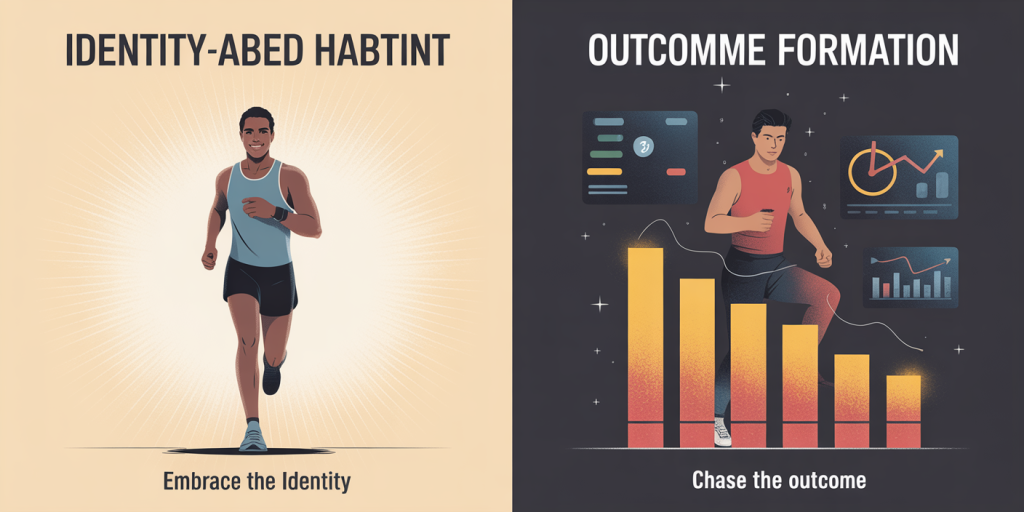The Role of Identity in Habit Formation: Why Who You Are Beats What You Do
In the realm of personal development, habit formation is often extolled as the gateway to success and lasting change. Traditional methods advise setting specific goals, following strict routines, or using external motivators to usher new behaviors into daily life. However, recent psychological research and practical experience suggest that a deeper factor influences habit persistence: identity. Rather than simply focusing on “what you do,” long-term behavioral change hinges on “who you believe you are.” This article explores the pivotal role identity plays in habit formation, substantiated with data, case studies, practical insights, and a comparative framework to articulate why identity-based habits have superior staying power.

Understanding the Power of Identity in Behavioral Change
The prevailing assumption in goal-setting circles is that achieving a behavior change depends on external triggers or conscious willpower. While these methods have their merits, they often falter when the initial motivation wanes. A more sustainable approach is rooted in identity—the internalized beliefs about oneself that influence perceptions, feelings, and actions.
Identity-based habit formation is grounded in the idea that people adopt behaviors that align with their self-image. As James Clear, author of *Atomic Habits*, explains, “Every action you take is a vote for the type of person you want to become.” This mindset shifts the focus from isolated behaviors to a more integrated sense of self, making habits more effortless and resilient. For example, instead of setting a goal to “run three times a week,” an identity-focused approach would emphasize becoming “a runner,” which naturally motivates ongoing behavior consistent with that identity.
Research supports this idea; a study by Wood and Neal (2007) found that habits tied to identity cues require less cognitive effort and have higher rates of automaticity and durability. These findings highlight that “self-concept congruent” habits reinforce identity and vice versa in a virtuous cycle.
How Identity Shapes Daily Habits: Psychological Mechanisms at Play
The mechanism behind identity influence lies in cognitive consistency theories. People strive for their behaviors to be congruent with their self-image to avoid psychological tension or cognitive dissonance. When an action supports who a person believes they are, it is psychologically rewarding and easier to sustain.
For example, a person who sees themselves as environmentally conscious will be more inclined to recycle and reduce waste regularly, even without external enforcement. This identity consistency provides intrinsic motivation, making the behavior feel authentic rather than forced.
Practical experimentation shows that deliberately attaching new habits to identity markers speeds up habit acquisition. In a 2015 study published in *Health Psychology Review*, participants who reinforced their health goals with identity affirmations (e.g., “I am a healthy eater”) were 41% more likely to maintain positive behavior changes over 3 months than those who focused on outcome-based goals.

Moreover, identity acts as a filter in decision-making. When faced with temptations or distractions, individuals rely on their identity “guidelines” to choose actions that reflect their core values and beliefs. This mental shortcut lightens cognitive load and increases the likelihood of behavioral consistency.
Practical Examples of Identity-Based Habit Success
Real-world examples illustrate how identity-driven habit formation works across domains. Take the case of Matt, a former smoker who struggled with relapse after numerous quit attempts. Instead of setting temporary goals like “not smoking for 1 week,” Matt embraced the identity of a “non-smoker.” He repeated affirmations, visualized his new identity, and aligned daily choices with this self-image. Over two years, Matt maintained smoke-free habits without constant willpower battles, a testament to identity’s transformative power.
Similarly, professional athletes often leverage identity to cultivate high-performance habits. Serena Williams, an iconic tennis player, emphasizes her identity as a “champion” and “fighter,” which governs rigorous training, diet, and mental preparation. This self-concept guides daily rituals and decisions, reinforcing habits that embody her elite athlete identity.
In workplaces, successful leaders encourage identity congruence to foster productive habits. Google’s Project Oxygen found that managers who saw themselves as “mentors” rather than just “bosses” were more consistent in providing team feedback and support, leading to better performance outcomes.
Table 1: Identity-Based vs. Outcome-Based Habit Formation Comparison
| Aspect | Identity-Based Approach | Outcome-Based Approach |
|---|---|---|
| Motivation Source | Internal self-concept | External goals/milestones |
| Behavior Maintenance | More durable due to self-reinforcement | Often temporary, reliant on rewards |
| Cognitive Effort Needed | Lower (automaticity through identity cue) | Higher (requires active willpower) |
| Response to Setbacks | Resilience due to identity commitment | Prone to relapse and discouragement |
| Example | “I am a runner” | “I want to run 5K” |
The Limitations of Traditional Habit-Formation Models
Despite the widespread adoption of goal-oriented plans and habit trackers, many people struggle to sustain new behaviors over time. This inconsistency often relates to a disconnect between identity and action.
Traditional models tend to focus heavily on external compliance, such as adherence to timelines, measurable outcomes, or reward-based incentives. While these techniques yield short-term successes, they lack the intrinsic reinforcement that identity provides. For example, someone might habitually floss their teeth for a week due to a dentist’s reminder but revert once the external prompt stops unless they internalize an identity as a “health-conscious person.”
Furthermore, research shows that “willpower depletion” is a significant barrier under these models. Baumeister’s ego depletion theory illustrates how willpower is a limited resource. By basing habits on identity, reliance on finite willpower decreases because behaviors are self-sustaining and align with how people see themselves.
An analysis of failed New Year’s resolutions from 2019 indicated that only 8% of people actually achieved their goals, largely due to superficial goal-setting unlinked to identity transformation. This data underscores the importance of anchoring behavioral change in one’s identity rather than merely setting outcome targets.
Techniques to Harness Identity for Habit Formation
Understanding the theory is essential, but implementing identity-based habit formation requires practical strategies.
One foundational approach is *identity affirmation*. This involves consciously defining and regularly reinforcing the identity associated with the desired habit. Writing statements like “I am a disciplined person” or “I am a mindful eater” daily helps embed this self-concept.
Another useful method is *habit stacking* connected to identity. For instance, someone identifying as a writer can stack the habit “write 200 words daily after morning coffee” to build momentum. This linking strengthens the habit’s tie to the self.
Visualization techniques also enhance identity-based habits. Athletes often mentally rehearse not just actions but their identity as a competitor, which primes automatic behaviors.
Social identity is another powerful lever. Group memberships shape identity and can boost accountability. Joining a community that shares the desired identity—for example, a running club or a meditation group—provides normative cues that reinforce habits organically.
Table 2: Practical Identity-Based Habit Formation Techniques
| Technique | Description | Practical Example |
|---|---|---|
| Identity Affirmation | Repeating identity-based statements | “I am a healthy eater” daily journaling |
| Habit Stacking | Linking habit to an existing routine | “After brushing, I meditate for 5 minutes” |
| Visualization | Mentally rehearsing the identity | Visualizing oneself as a confident public speaker |
| Social Identity Leverage | Using group affiliation for reinforcement | Joining a marathon training group |
Future Perspectives: The Evolving Science and Application of Identity in Habits
The role of identity in habit formation is gaining traction not only in psychology but also in technology, education, and workplace innovation. Future developments will likely integrate personalized identity-driven habit coaching powered by AI, allowing for customized behavioral interventions that tap directly into an individual’s values and self-images.
Emerging neuroimaging studies also aim to map how identity-related brain circuits activate during habit formation, potentially unveiling biological mechanisms behind identity’s motivational power. This could lead to precision therapies for behavioral change among populations with addiction or chronic illnesses.
Moreover, the rise of wearable technology and biometric feedback may allow users to monitor if their habits align with their self-concept in real time. Such integration could enhance self-awareness and accelerate the consolidation of identity-based habits.

In educational settings, fostering positive student identities—like “I am a curious learner” or “I am a critical thinker”—may revolutionize pedagogy by improving engagement and reducing dropout rates. Similarly, organizations might prioritize employee identity alignment to boost productivity and job satisfaction.
These future applications underscore a paradigm shift: habit formation moving from external checklists toward holistic identity transformation as the cornerstone of sustainable personal and societal change.
By recognizing that “who you are” profoundly influences “what you do,” this framework empowers individuals to create lasting habits that genuinely reflect their true selves. Cultivating identity-aligned habits is not just a strategy for behavior change—it is a route to becoming the person you aspire to be, fundamentally reshaping lives with more resilience, authenticity, and success.
